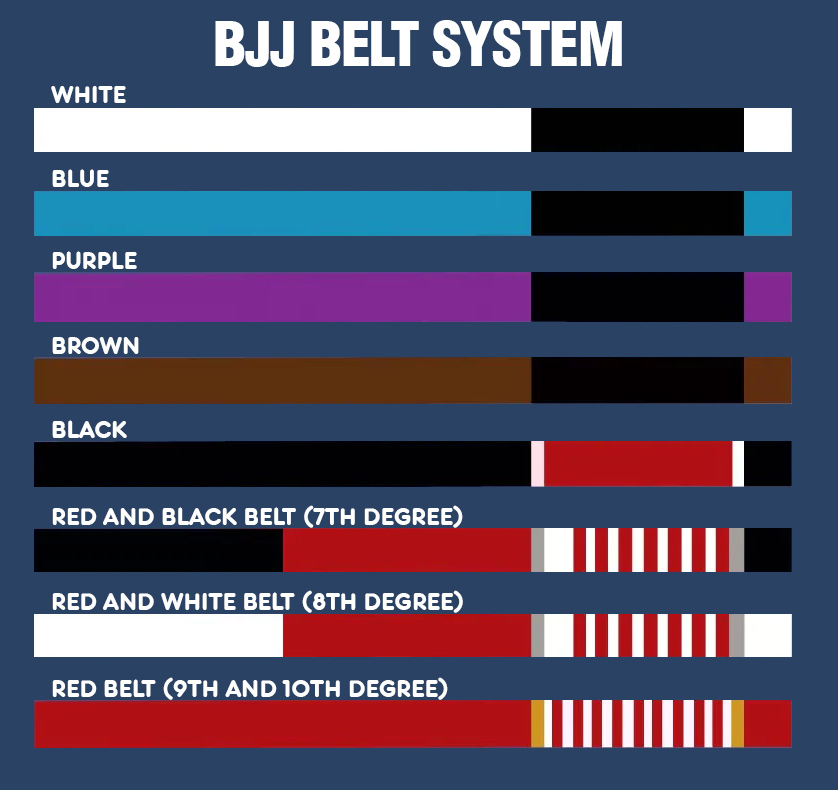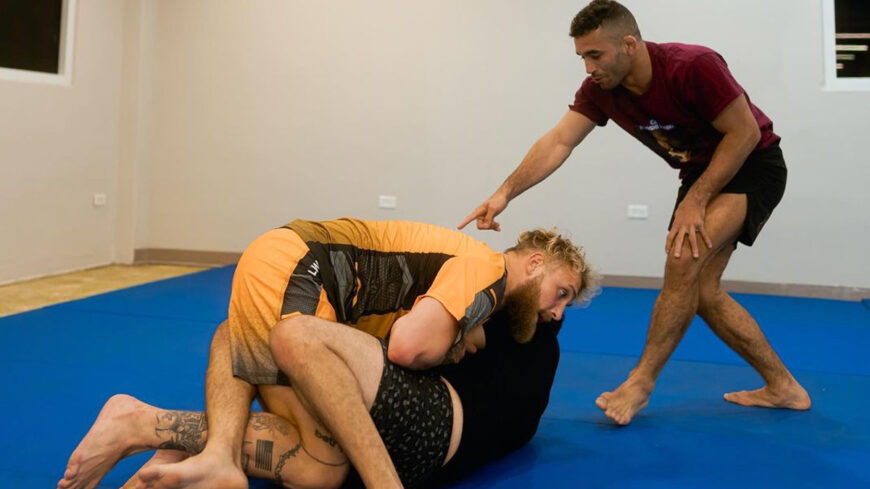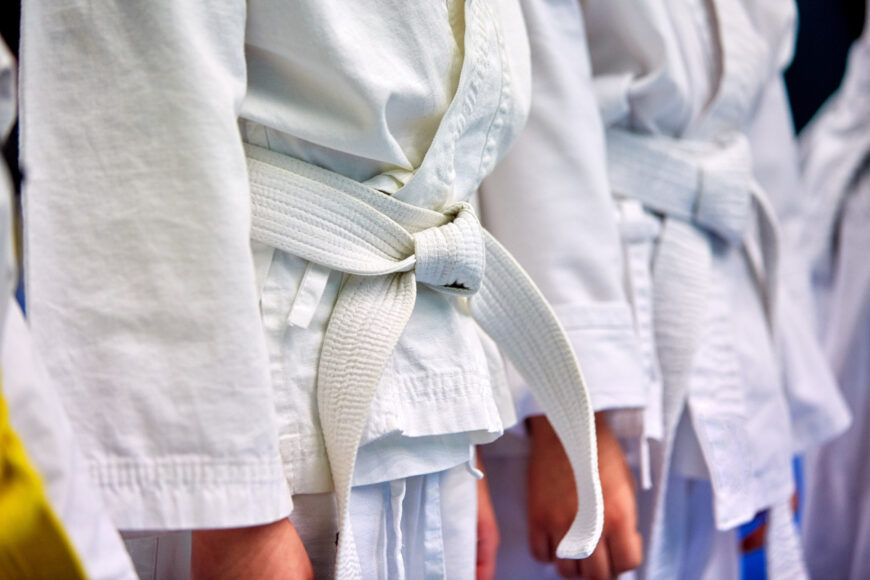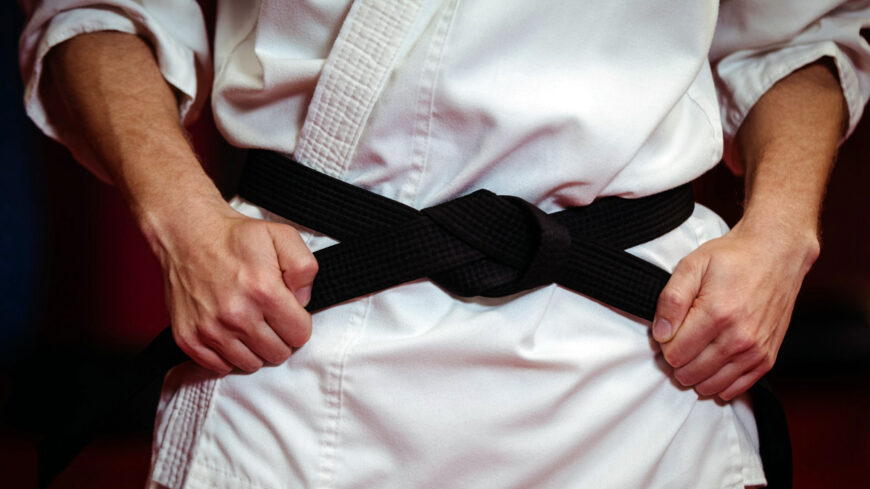Brazilian Jiu Jitsu is a popular martial art and combat sport. One of the most unique aspects of BJJ are the colored belts that identify practitioners’ level of achievement in the sport.
This blog post will explore the Brazilian Jiu-Jitsu belt system, offer an overview of each belt, explain how one goes about earning a BJJ belt, and uncover other little known details about these powerful symbols of achievement. Read on to deepen your appreciation for this impressive martial art and its special system for recognizing individual achievements!
A Brief History of BJJ Belts
Tracing back to the 1800s, BJJ belts have been part of and a symbol of progress in martial arts.
Origin of BJJ Belts
The history of the Brazilian Jiu-Jitsu belts dates back centuries. It is said to have originated in Japan during the 15th century and was brought to Brazil by Mitsuyo Maeda, a Japanese Judoka who taught Jiu-Jitsu to Carlos Gracie Sr., inspiring him to create the “Gracie jiu-jitsu” style of martial arts.
The history of the Brazilian Jiu-Jitsu belts dates back centuries; it’s generally presumed that the first belt system was introduced in 1967 in Rio de Janeiro, based on the judo belt system that was invented by Kanō Jigorō in 1907. It is said to have originated from judo, which was founded by Kanō Jigorō in 1882; however, judo itself was influenced by various Japanese martial arts that date back to ancient times. It was brought to Brazil by Mitsuyo Maeda, a Japanese judoka who taught jiu-jitsu to Carlos Gracie Sr., inspiring him to create the “Gracie jiu-jitsu” style of martial arts.
Over time, it has become an important part of Brazilian culture; its symbolism being deeply rooted in traditional values such as loyalty, hard work and dedication. The belt system gives students a sense of progress; each color conveys increased knowledge about the art and techniques used for self-defense. However, there are also different belts for children and adults, with different requirements and expectations for each rank.
Significance of Colors
The colors of the BJJ belts are an important part of the martial art’s tradition; each belt has its own significance, representing a different level of mastery and skill in the sport. White is traditionally seen as the beginning level; blue is often seen as intermediate; purple signifies advanced knowledge; brown symbolizes mastery; black represents elite expertise. Each color does not indicate a specific style or school of jiu-jitsu; rather, it indicates the general level of proficiency and knowledge that a practitioner has acquired.
At white belt, practitioners learn basic techniques while developing their fundamental physical and mental skills needed for continued progress in BJJ. As students become more adept with their skills and knowledge they progress to blue belt where they learn more complex moves and begin refining their basics learnt at white belt. At purple belt level, practitioners develop specific game plans by improving their positional tactics, transitions, submissions and escapes. Brown belt signifies high-level technical ability and proficiency in all areas of jiu-jitsu. It also implies some teaching capabilities and leadership qualities. Black belt marks elite expertise and mastery over all aspects of Brazilian Jiu Jitsu. It also implies responsibility for spreading and preserving the art as well as mentoring lower ranked belts.
Aside from these regular colored belts, there are other belts available which represent special accomplishments within the sport such as red-and-white belts for those who achieve great results in competition but do not pass all requirements for second degree black; coral for 4th-6th degree black belts; red for 7th – 8th higher degrees; green-and-yellow stripe – kodokan judo 1st , 2nd dan respectively; grey/white striped belts signify “Grace Period” before certain athletes can be promoted to next rank if competing organization so allows etc.
The Brazilian Jiu-Jitsu Belt System
The Brazilian Jiu-Jitsu belt system has eight belts, each one representing a different level of skill and knowledge. The belt system has its origins from Kodokan Judo, but it has evolved over time to reflect the unique aspects of BJJ. Read on to learn more about the BJJ belt system!

1. White Belt
The white belt is the beginning rank for any BJJ practitioner. It marks a time of learning and exploration, as well as developing one’s fundamentals.
At this stage, students should focus their efforts on understanding the basic techniques and moves of Brazilian Jiu-Jitsu. There are no prerequisites to joining a class or competing in a tournament as a white belt – all you need is an eagerness to learn and participate.
In addition, it’s important for students to remember that even after earning higher belts, they must always treat their white belt with respect – representing humility by never forgetting where they started from. According to statistics, there are 2,945,240 people practicing BJJ – of which 90% never get past their blue belt signifying how difficult it can be to progress through the ranks. Earning a white belt takes dedication and patience; however when done correctly can be extremely rewarding both physically and mentally.
2. Blue Belt
Blue is the second belt in the Brazilian Jiu-Jitsu belt system. Earning a blue belt requires dedication and hard work.
To attain a blue belt, students must have a mastery of BJJ basics like breakfalls, escapes, sweeps and submissions. Students should also have an understanding of at least one guard variation as well as concepts like transitions and pressure passing.
There are eligibility requirements for attaining a blue belt such as minimum age or number of training hours required which vary depending on affiliation or organization. Some schools may also emphasize self-defense principles as part of their criteria. After earning the blue belt, martial artists can deepen their knowledge by developing sharper techniques to become ready for purple belts that follow. With nearly 90% never getting beyond this rank according to statistics from the International Brazilian Jiu-Jitsu Federation (IBJJF), applicants need determination and effort in order to progress further along their journey towards black belts in martial arts training.
3. Purple Belt
The purple belt signifies a significant level of proficiency in Brazilian Jiu-Jitsu. It is the third rank given to practitioners who have obtained their blue belt and have gathered enough knowledge, skills and technique necessary to qualify for a promotion.
A practitioner must demonstrate an advanced understanding of BJJ moves and positions before being eligible for this rank. Usually it takes at least two years of consistent training after earning a blue belt before being eligible to receive a purple belt, but in some cases it may take longer depending on the individual’s progress as recognized by their instructor.
Advantages of having a purple belt include gaining more respect from peers, taking part in more class instruction, leading technical sessions and even teaching full classes or refereeing tournaments. According to statistics only 10% percent will earn their purple belt within four to five years of starting BJJ, making those with purple belts rarer than higher-ranking belts such as brown or black belts.
4. Brown Belt
Brown belts are the fourth degree of belt in the Brazilian Jiu-Jitsu (BJJ) belt system and is a level which many BJJ practitioners aspire to achieve. It typically takes about three years of training, competing, and proving technical understanding to earn a brown belt after earning their purple one.
Brown belts require extensive knowledge on all positions and techniques from white to black as they serve at both an assistant instructor level or as an independent instructor. They must demonstrate strong self-defense skills, tactical ability, physical endurance, mental fortitude and emotional control when sparring with opponents or teaching students how to perform the various moves. In order for one to be promoted from being a brown belt into a black belt requires an even higher standard that is set by each respective organization such as the International Brazilian Jiu-Jitsu Federation (IBJJF).
According to the IBJJF standards, the person to be promoted for brown belt should be at least 18 years old and have spent a minimum of 18 months as a purple belt5. Upon promotion, the student must remain a brown belt for at least one year before being eligible for a black belt.
5. Black Belt
Black belt is the ultimate rank in Brazilian Jiu Jitsu. Earning a black belt signifies one’s dedication, commitment and skill in BJJ.
To become a black belt requires many years (around 10 to 13) of intense study and practice. The holder of a black belt has mastered all the basics, fundamentals, strategies and techniques relevant to their field of expertise.
A black belt practitioner has immense knowledge about martial arts principles and strategies that help him or her during sparring conditions as well as competition matches. Not only do they understand how to defend themselves against an opponent but also how to dominate an opponent through aggressive attacks while staying safe in any situation.
According to the IBJJF rules, no one can be a black belt in jiu-jitsu before 19 years of age. You can only be promoted to black belt by a black belt instructor with a minimum of 2 degrees. After three years of receiving the black belt, the athlete may request the 1st degree. There are 9 degrees of black belt in jiu-jitsu, each requiring more time and experience than the previous one.
In addition to meeting the skill and knowledge requirements for a black belt in Brazilian Jiu-Jitsu, there are other requirements for becoming an International Brazilian Jiu-Jitsu Federation (IBJJF) certified black belt. These requirements include providing a CPR and first aid certificate, being affiliated with the IBJJF, passing an IBJJF referee course with a score of at least 60%, being an assistant instructor or supervisor at an IBJJF gym, and being promoted by an IBJJF-accredited 2nd-degree black belt instructor. It’s important to note that these requirements may vary depending on the specific organization or association through which one is seeking certification.
Other Belts In The BJJ Belt System
Within the BJJ belt system there are additional belts beyond the white, blue, purple, brown and black level. For anyone interested in learning more about these unique belts and their specific requirements to achieve each one – keep reading!
6. Red and Black Belt (The 7th Degree Black Belt)
Red and black belts are the seventh degree of belt in Brazilian Jiu-Jitsu (BJJ). It is usually awarded to adult, male practitioners with at least 31 years of training experience since earning their black belt.
The main requirements for earning a red and black belt include technical proficiency, knowledge of advanced techniques and an ability to teach BJJ at a competitive level. The red and black belt is recognized by the International Brazilian Jiu-Jitsu Federation (IBJJF), and its holders are known as “Masters”.
Practitioners who reach this rank have become exemplary mentors and educators within the martial arts community. Earning a red and black belt requires dedication, hard work and loyal commitment to perfecting one’s craft – all traits that characterize true masters of their art form.
According to the IBJJF rules, you must have been awarded your black belt 31 years prior to be eligible for a red and black belt. You must also remain at this rank for a minimum of 7 years before moving up to the next degree.
7. Red and White Belt (The 8th Degree Black Belt)
Red and white belts are special belts awarded to those who have achieved a high level of mastery in Brazilian Jiu-Jitsu. This belt usually signifies the 8th degree black belt, according to the International Brazilian Jiu-Jitsu Federation (IBJJF).
The red portion symbolizes danger—the wearer should be respected as a highly skilled martial artist. The white stripe in the middle represents purity and knowledge – this indicates that the individual has reached their highest level of proficiency. Additionally, there can also be several stripes around the edge which represent many years of dedication and discipline required to attain such an elite rank.
8. Red Belt (The 9th and 10th Degree Black Belt)
The red belt is a ninth or tenth degree black belt, the highest possible rank that a living practitioner of BJJ may attain. It is rare to find practitioners at this level due to the long time requirements and commitment necessary to achieve it.
As of 2021, there are less than 70 people who have achieved this rank in the world.2 The red belt represents mastery and authority in Brazilian Jiu-Jitsu, as well as respect from all corners of the BJJ community: from students to instructors, from affiliates to competition referees. Earning a red belt requires dedication and years of hard work — typically 15 years or more — as well as expertise across all aspects of BJJ such as self-defense, sport competitions and technical teaching ability.
Learn everything about BJJ Red Belt.
BJJ Belt System for Kids aged 4-15
| Belt | Minimum Age Requirement |
|---|---|
| White | None |
| Grey and White | 4-15 Years |
| Grey | 4-15 Years |
| Grey and Black | 4-15 Years |
| Yellow and White | 7-15 Years |
| Yellow | 7-15 Years |
| Yellow and Black | 7-15 Years |
| Orange and White | 10-15 Years |
| Orange | 10-15 Years |
| Orange and Black | 10-15 Years |
| Green and White | 13-15 Years |
| Green | 13-15 Years |
| Green and Black | 13-15 Years |
Notes:
- There is no time limit to progress through the children’s belt system, but there is an age limit.
- Once a child turns 16, they will be promoted to the adult Jiu-Jitsu program, and they will be given one of the adult belts mentioned above by their BJJ instructor.
- According to the International Brazilian Jiu-Jitsu Federation (IBJJF) rules, the promotion belt for children depends on their current belt. Those who hold the White Belt will receive the White Belt again upon turning 16. Those with the Grey, Yellow, or Orange Belts will receive the Blue Belt, while those with the Green Belt may receive either a Blue or Purple Belt, depending on their instructor’s decision.
Key Facts
- There are more than 10,000 BJJ Schools in America.
- There are more than 7,425 BJJ black belts.
- 90% of people who start BJJ never get past their blue belt.
- There are 2,945,240 people practicing BJJ.
- The average person practicing BJJ is a 30 year old, blue belt, male.
- Only 10% of new BJJ students will earn a blue belt.
- Of that 10 percent, only 1% will earn a black belt.
Earning A BJJ Belt
Earning a BJJ belt is a challenging and rewarding process that requires dedication, discipline and skill. Each rank comes with its own unique set of expectations and responsibilities. In this article, readers can find out more about the journey to a black belt in BJJ.
Eligibility Requirements

Earning a BJJ belt is not an easy process. In order to qualify for promotion, students must demonstrate technical and physical proficiency as well as prove their understanding of the fundamental concepts of jiu-jitsu. Generally, each student should have a minimum of 3 months training in order to be eligible for promotion. However, this varies from one academy to another and some may require more time before testing for higher belts.
Age is also an important factor in determining eligibility for promotion. Most academies will not allow students under the age of 16 years old to test for adult belts. Additionally, some schools have different requirements based on age when it comes to lower ranks like white and blue belts––students between the ages 15-17 are typically allowed to promote faster than adults over 18 years old according to IBJJF guidelines.
The length of training and age limits are only two factors that determine eligibility requirements; other qualifications may include having prior competition experience, teaching or assisting instructors in classes and demonstrating consistent good behavior at all times both on and off the mats which includes proper attitude towards others in class etc. Each school has its own guidelines so it’s important that potential black belts understand any additional rules set by their own particular club or instructor before attempting any graded exams during their journey towards achieving their BJJ goals.
Duration Of Training For Each Belt
The Brazilian Jiu-Jitsu (BJJ) belt system can be daunting for newcomers. Unlike many other martial arts that give belts on a more subjective basis, BJJ follows a standardized and structured belt progression system. The BJJ belt system has its roots in Japan, with Jigoro Kano’s Kodokan Judo. However, Carlos and Hélio Gracie developed their own Gracie jiu-jitsu belt system in 1952.
The amount of time it takes to earn each belt in BJJ varies depending on the individual. Generally, a white belt will take around six months to two years before they can grade for their blue belt. After this, it typically takes at least two to five years or more of consistent training before a practitioner is eligible for their purple belt. Earning a brown and black belts usually requires 8-10 years of commitment and dedication in order to achieve the highest level of expertise.
While there are guidelines that many instructors follow when grading their students, every instructor may have different requirements as well as minimum time required for promotion up until black belt. There is no set rule when it comes to earning BJJ belts; thus, some practitioners may take longer or shorter than others to achieve the next rank due to various factors such as age, commitment level and knowledge gaps between themselves and other students.
The White Belt
The white belt is the initial level in BJJ, where students learn fundamental techniques and develop basic skills.
Basics Of The White Belt
The basics of the white belt for Brazilian Jiu-Jitsu involve learning basic positions and techniques to understand, defend and attack during a match. The primary focus for a white belt should be on developing fundamentals through drilling, repetition and exposure to different techniques.
Control is also an important part of a white belt’s progress as they learn how to maintain good positioning in order to apply submission holds or escapes as needed. According to statistics, only 10% of new BJJ students will earn their blue belts within two years or less due to the amount of dedication required.
Developing Fundamentals
At the white belt level of Brazilian Jiu-Jitsu, practitioners are just beginning to understand the basics. This includes techniques such as hip movements, escapes from bad positions and submissions.
It is important for a white belt to focus on developing fundamentals first in order to be successful in BJJ. Learning basic techniques can help the practitioner have more control over their opponent during a match and make better decisions while defending or attacking submissions.
With a good foundation of intense practice, a student will gain confidence which leads to higher success rates in tournaments. As per statistics, only 10% of new BJJ students will get past blue belt level so developing strong fundamentals is essential for achieving long term progress in this martial art form.

The Blue Belt
The blue belt is an important milestone for BJJ practitioners and signifies a serious commitment to the art. To learn more about blue belts, what they mean and how to get there, read on!
Learning Advanced Techniques
The blue belt is the first rank one can achieve where advanced techniques are taught. It begins an important phase of a disciple’s BJJ journey, wherein they begin to develop their personal style.
This is done by learning and mastering more complex defensive strategies such as sweeps, takedowns, guard passes and submissions. To reach this higher level of knowledge, students must also refine their fundamentals developed as a white belt before moving on to new techniques.
With targeted training and instruction from qualified instructors, blue belts become proficient in self-defense against resisting opponents while using joint locks and various submission holds. Around 90 percent of those who start Brazilian Jiu Jitsu never get past the blue belt stage due to its difficulty compared to previous belts; only 10 percent of new BJJ students will earn one within two years minimum time required for promotion.
Refining Basics
The white belt level is when a BJJ practitioner begins to learn the basics of the art. It is extremely important for practitioners at this level to take classes and drills seriously since they are laying the foundation of their Jiu-Jitsu game. The blue belt level is where they start refining those basic movements and learning more advanced techniques, positions, and strategies. At this level, each student will have a better understanding of what works best for them based on their body type and abilities. They start developing their own personal style through experimentation in training sessions with other practitioners.
At this stage, it’s not about showing off flashy or complicated moves but about perfecting fundamental techniques so that each movement flows seamlessly into another one as well as creating an arsenal that you can draw from when grappling against various opponents. For example, mastering a specific guard position such as De La Riva Guard would involve practicing drilling certain combinations dozens of times before being able to execute them perfectly during sparring. Achieving proficiency requires lots of repetition combined with continuous analysis of your techniques by knowledgeable instructors and fellow practitioners who provide advice along the way on how to improve every aspect of your game.
The De La Riva Guard is a type of open guard that was popularized by a legendary BJJ competitor named Ricardo De La Riva. It involves wrapping one leg around the opponent’s standing leg and hooking your foot behind their knee, while controlling their other leg with your hand and placing your other foot on their hip or biceps. This creates a strong connection with the opponent and allows you to off-balance them and set up sweeps, submissions and back takes .
The Purple Belt
Growing Knowledge and Skills and Developing a Personalized Style, the Purple Belt requires practitioners to refine their skills before progressing further.
Growing Knowledge And Skills
Once a student has achieved their blue belt, they enter the realm of intermediate Jiu-Jitsu. It is at this stage that students begin to refine techniques learned at lower belts and learn new complex movements such as escapes, sweeps and submissions.
To be eligible for a purple belt, there are certain time requirements that must be met; typically four to five years after achieving the blue belt rank. Earning a purple belt means that considerable skill has been developed in some areas rather than mastering them all completely – 90% of BJJ practitioners never get past the blue belt level.
Proficiency in technique is paramount as well as having an aptitude for self defense, strategy development and problem solving tactics in high stress situations. Only 1% of BJJ students will make it to black belt ranking making purple one of the most sought after belts for ambitious martial arts fans.
Developing A Personalized Style
Once a BJJ student has reached the purple belt level, their understanding of Brazilian jiu-jitsu becomes more advanced. They will develop and refine their own style of grappling that is tailored to their strengths and weaknesses.
At this stage, they start to explore the details of techniques such as timing and body positioning rather than simply trying to perfect basic moves. With consistent training and practice, students can continue to progress in technical knowledge while also developing a personalized form of fighting that fits them best.
According to statistics, only 1% of people who engage in BJJ ever make it beyond blue belt. Those that do are rewarded with an opportunity to utilize their unique set of skills within a grappling context, giving them an unparalleled edge against opponents.
The Brown Belt
Gaining a Brown Belt signifies that a BJJ practitioner has developed the necessary skills and knowledge to become an instructor, showing their remarkable dedication and achievement in Brazilian Jiu-Jitsu. Read on to find out more about what is required for attaining this milestone!
Becoming A Teacher
The Brown Belt is the penultimate level in Brazilian Jiu-Jitsu and marks a significant milestone for practitioners. To receive your Brown Belt, you must demonstrate technical proficiency as well as a great knowledge base as an assistant instructor. Only 10% of new BJJ students will earn their Blue Belt, while only 1% attain their Black Belts. Earning a Brown Belt requires dedication and commitment to showing continual progress throughout five to six years of training and competing.
In addition to demonstrating ability with techniques, it is also important to show your skill in teaching other students who are attempting the same techniques at lower levels such as White Belts or even Blue Belts still refining basics. In some cases potential instructors may need to wait at least one year from reaching Purple belt before attempting promotion to Brown (or higher.) It is also possible for long-term experienced practitioners who show exceptional talent in martial arts instruction but lack sufficient competition record be promoted directly from Blue Belt up one rank straight to Brown belt indicating recognition of both extraordinary skill combined with practical experience teaching others.
Barriers To Earning A Brown Belt
Earning a brown belt in Brazilian jiu-jitsu (BJJ) requires dedication and commitment. It is one of the highest ranks in the sport, which follows a standardized and structured belt progression system. The BJJ belt system has its roots in Japan, with Jigoro Kano’s Kodokan Judo. Unlike today, Kano used only white, brown, and black belts with his students. Similarly, in the early days with the Gracie family in Brazil, Carlos and Hélio used only white and blue belts to distinguish students from instructors.
To attain a brown belt, practitioners must meet high standards of technical and physical skills. They must also have trained consistently for several years – typically 8-11 depending on age and experience – with 10 years being average based on data from over 7 thousand black belts worldwide who submitted information. During this time period, students should focus heavily on refining basic techniques alongside developing new ones; emphasizing superiority in all positions so they can control their opponents or transition into submission quickly when opportunity presents itself. Additionally, true martial artists also take care to improve their body awareness by drilling regularly while focusing on proper breathing techniques which helps cultivate proficiency in controlling one’s own emotions during sparring sessions.
It is important that students understand the importance of having good technique rather than relying solely on brute strength if they hope to achieve success at higher ranks such as brown belt or even eventually get promoted to black belt status. According to Webmaster’s “blackbelt map”, which tracks thousands of BJJ practitioners worldwide, only 1% have done so thus far. This demonstrates just how difficult yet rewarding reaching this milestone may be – necessitating ongoing self-discipline and perseverance until finally attained!
The Black Belt
The Black Belt symbolizes achievement in BJJ, with variations in ranking between different organizations.
Symbol Of Achievement In BJJ
The black belt is the highest rank achievable in Brazilian Jiu-Jitsu and is recognized around the world as a symbol of achievement. Earning one takes years of dedication, skill and passion for the martial art.
According to statistics, only 10% of new BJJ students will earn a blue belt, and out of that 10 percent, only 1% will make it all the way to a black belt. In addition to mastering techniques like locking, choking and controlling an opponent while resisting their attacks, practitioners must also progress through various colored belts before achieving a black belt. The BJJ belt system has its roots in Japan, with Jigoro Kano’s Kodokan Judo. Unlike today, Kano used only white, brown, and black belts with his students. Similarly, in the early days with the Gracie family in Brazil, Carlos and Hélio used only white and blue belts to distinguish students from instructors.
The average person practicing BJJ is a 30 year old male at blue belt, thus further emphasizing how difficult it can be to reach this elite level. Of those who achieve it though there are some notable names such as Webmasters with 61542 points or Christian Graugart with 52725 points according to ranking systems implemented by organizations such as IBJJF or ADCC. Achieving one’s black belt marks someone’s journey from novice student into becoming an assistant instructor capable of teaching fundamentals from their own experience; But it does not end there since masters usually carry multiple degrees in order for their students don’t worry about having too much time invested into getting another degree associated with higher rankings like coral belts or red belts.
Variations In Black Belt Rankings
The black belt is the highest rank achievable in Brazilian Jiu-Jitsu and signifies a high level of skill and experience. However, there are variations in black belt rankings that indicate different degrees of mastery within the art. Most martial arts organizations use a system of stripes or bars on the black belt to show the progress of a practitioner from one degree to another. The number of degrees varies depending on the organization, but typically ranges from six to ten.
In Brazilian Jiu-Jitsu (BJJ), promotion from one black belt degree to another usually depends on factors such as lineage, time spent at each rank, competition success and contribution to the art.
For example, according to the International Brazilian Jiu-Jitsu Federation (IBJJF), one of the most influential organizations in BJJ, a practitioner must spend at least three years at each degree before being eligible for promotion. The IBJJF also awards special belts for higher degrees: a coral belt (red and black) for 7th and 8th degrees, and a red belt for 9th and 10th degrees. These belts are reserved for exceptional masters who have dedicated their lives to BJJ and have made significant contributions to its development and dissemination. The red belt is also considered an honorary rank for the founders of BJJ, such as Carlos Gracie Sr., Helio Gracie and Oswaldo Fadda.
The Significance Of Stripes On BJJ Belts
Stripes on BJJ belts are used to indicate a student’s progress and skill level within each rank. They are usually pieces of athletic tape that instructors wrap around their students’ belts after they demonstrate certain criteria. Stripes have different meanings depending on the belt color and the organization, but generally they represent successful technique advancements, experience and dedication to the art. Continue reading to find out more about the significance of stripes in the BJJ belt system!
Representing Successful Technique Advancements
Stripes are awarded to students who show improvement and proficiency in various aspects of BJJ, such as defense, offense, transitions, submissions and escapes. Each stripe requires demonstration of a specific skill or knowledge level that is appropriate for the belt rank. For example, a white belt may need to show basic understanding of positions and escapes, while a brown belt may need to show advanced techniques and strategies.
Earning stripes provides extra motivation for students to continue honing their skills and learning new concepts within their belt rank. It also helps them prepare for the next belt promotion, which usually requires four stripes on each belt from white to brown.
Achieving A Higher Rank
Achieving a higher rank in BJJ requires dedication, hard work and practice. There are various organizations with different belt criteria and rankings such as IBJJF, ADCC and FJJRIO. Each organization has its own rules and requirements for promotion, which may include factors such as time spent at each rank, competition success, contribution to the art and instructor’s evaluation.
Promotion from one belt rank to another is not automatic or guaranteed; it depends on the student’s performance and progress. Earning stripes is one way of showing readiness for promotion, but it is not enough by itself. Students must also demonstrate their skills in front of their instructors or other black belts who can assess their level.
Competitions play an important role for promotion as well as obtaining points necessary for advanced ranking such as red or coral belts within IBJJF’s adult belt system. Experience is key when striving for higher ranks; minimum time requirement exists depending on the organization’s structure or instructor goals since each student develops differently.
Demonstrate Physical And Technical Growth
Physical and technical growth are two essential aspects of progressing in BJJ. They require hard work, commitment and dedication to the sport, as well as proper guidance from instructors and good self-discipline.
To demonstrate physical growth, students must improve their strength, endurance, speed, agility and flexibility, as well as their overall body structure. Physical training can help them perform better on the mats, prevent injuries and cope with the intense psychological and physiological changes that come with close physical contact.
To demonstrate technical growth, students must learn and master various techniques and positions, as well as develop their ability to transition smoothly and adapt to different situations13. Technical training can help them gain confidence, creativity and problem-solving skills that are useful both on and off the mats.
There are many challenges and rewards for those who pursue physical and technical growth in BJJ. According to some estimates, there are 10,000 BJJ schools in America with close to 7,500 black belts representing the highest level of skill and experience. However, only 1% of all practicing students will earn their black belt, showing how much time and effort it takes to reach that level. Some practitioners may stand out for their exceptional achievements or dedication, such as Webmaster who accumulated 61,542 points and became the highest ranked BJJ practitioner. But regardless of age or gender, anyone can achieve new heights in Brazilian Jiu-Jitsu if they are willing to work hard and learn from others.
Different BJJ Organizations And Their Belt Ranking Systems
BJJ organizations such as IBJJF, ADCC, and FJRIO all have their own belt ranking systems. To learn more about these systems, continue reading!
IBJJF
The International Brazilian Jiu-Jitsu Federation (IBJJF) is one of the most renowned and respected BJJ organizations in the world. It was founded by Carlos Gracie Jr. with the purpose to unify, regulate and promote the growth of jiu-jitsu worldwide. The IBJJF belt system follows a similar structure to that of other BJJ organizations, however their belts are obtained faster compared to others. White, blue, purple and brown belts achieve their respective rankings relatively quickly with black belt ranking taking at least four to seven years depending on skill level.
The IBJJF awards its competitors points for winning or placing in tournaments or matches. These points contribute towards being able to receive promotions for each corresponding color belt– white through black–and also stripes on those belts if enough points have been accumulated within a certain amount of time from achieving that particular rank. At some point during a student’s journey around blue-belt territory they will earn an instructor status called “assistant instructor” once they’ve accumulated enough points – usually between 50-000 overall tournament results since turning 6 years old regardless how long it has taken them from white up till now. Those students can already teach classes but cannot grade students yet – this requires a high level black belt quality rarely seen among grapplers.
ADCC
ADCC stands for Abu Dhabi Combat Club. It is an international submission grappling tournament held in Abu Dhabi, United Arab Emirates, with participant athletes coming from various disciplines such as Brazilian Jiu-Jitsu, Wrestling and Judo.
ADCC has become one of the most sought-after championships amongst MMA and Martial Arts enthusiasts and professionals in the industry. Since its inception in 1998, over 600+ world champions have participated including prestigious grapplers Rickson Gracie, Roger Gracie and Marcelo Garcia who hold multiple ranks on this competitive platform. With a powerful finesse of competitors from all over the world competing in open weight classes for both men’s and women’s divisions this tournament is definitely something to watch out for!
Unlike other BJJ organizations, ADCC does not have a belt ranking system. Instead, it uses a point system based on how well the competitors perform at each of the ADCC trials they enter in hopes of winning a ticket to Las Vegas in September. The points are calculated based on the number of matches won, submissions achieved, weight class entered and trials location. he top-ranked competitors from each weight class are invited to compete at the ADCC World Championship which is held every two years.
FJJRIO
FJJRIO is an internationally renowned Brazilian Jiu-Jitsu federation. Founded by world champion Ricardo de la Riva in 1991, FJJRIO has often been credited with developing and modernizing the sport of BJJ.
FJJRIO’s belt ranking system consists of the same basic colors (white, blue, purple…) as seen in other organizations but also includes a rare sixth-degree black belt for exceptionally skilled practitioners. To earn a sixth-degree belt from FJJRIO requires partnership approval and 5 years or more of continued training at the highest levels in competition. Additionally, only black belts ranked fifth degree or higher are eligible to become certified instructors under FJJRIO’s program.
Other Organizations
Organizations like the International Brazilian Jiu-Jitsu Federation (IBJJF) and the Abu Dhabi Combat Club (ADCC) have their own unique belt ranking systems. The IBJJF has nine belts in its system, including white, blue, purple, brown, black, red and black (coral), red and white (coral) and red. The IBJJF also has a separate graduation system for kids with different colors and stripes.
ADCC uses a more simpler system with only four colors: white, blue, yellow and green. There are also other organizations outside of these two major ones such as the FJJRIO that use six colors – white, blue, purple, brown, red and black. Each organization’s rank requirements vary but they all follow similar standards for earning a promotion to each belt level. Some organizations also have an athlete ranking system based on points earned from competing in tournaments.
FAQs:
1. What are the different colored belts in Brazilian Jiu Jitsu?
In Brazilian Jiu Jitsu, colored belts correspond to experience and level of skill; from white (beginner) to black (expert). The order is as follows: white, blue, purple, brown and then finally black. Some organizations also have higher ranks such as coral (red and black or red and white) and red belts for distinguished masters.
Each belt has different requirements for promotion, such as time spent training, technical knowledge, competition performance and instructor evaluation. There are also usually four “degrees” or stripes for each belt below black belt, and six degrees at black belt that indicate further progress within each rank. The average time it takes to achieve a black belt is around 10 years, but it can vary depending on many factors.
2. How long does it take to earn each belt in BJJ?
The amount of time it takes is highly subjective and depends upon training frequency, individual dedication and ability however a reasonable estimation would be two years per belt working on average 4-5 days a week under an experienced instructor/ mentor with proper guidance throughout the process.
3. Do I need special equipment for my BJJ Belt?
No extra equipment is needed for your BJJ belt aside from either a standard jiu jitsu Gi or rash guard depending upon which type you choose when purchasing one new – both can be found easily online or at martial arts supply stores nearby with various sizes & materials available depending upon preferences made prior purchase by customer(s).
4 Is there any etiquette involved in wearing one’s BJJ Belt ?
Yes – traditionally speaking there’s an unspoken code associated with respecting others when sporting their respective colors depending upon rank & class levels when attending practice(s) sessions together; including simple behaviors such as not touching someone else’s instead using words for prompting movement if necessary so respect among peers remains intact as much possible amongst practitioners regardless where located geographically throughout world today!
More on BJJ:
- Which Martial Art Black Belt Takes The Longest Time?
- The 7 Best Martial Arts For Self-Defense
- How To Choose The Right Martial Art?
- The Ultimate Brazilian Jiu Jitsu Guide For Beginners
- Best Ways To Improve Flexibility For Brazilian Jiu-Jitsu
- Workouts To Build Explosive Strength For Jiu-Jitsu
- Why Your Jiu-Jitsu Isn’t Getting Better
Conclusion
BJJ belts are an important aspect of Brazilian Jiu-Jitsu and they represent different levels of skill and knowledge. From white to black belts, students advance through the ranks as they learn and improve their abilities.
Achieving each belt requires commitment, discipline, and consistent practice in order to master the techniques required for each level. As a student progresses from one color to another they gain experience while developing self-confidence, wisdom, and respect.
Each colored belt in BJJ has its own unique set of challenges that will test the student’s limits and help them grow both mentally and physically. With determination, anyone can achieve success on their BJJ journey!









